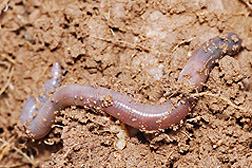This page has been archived and is being provided for reference purposes only. The page is no longer being updated, and therefore, links on the page may be invalid.
|
|
|
|
Role of Earthworms in Soil Explored
By Don ComisJuly 18, 2008
The right earthworms can make home septic systems work better. The wrong ones could do the opposite.
That’s the finding in a study of worm populations living in the soil near trenches receiving septic tank flow outside five single family homes in Arkansas. Carrie L. Hawkins of the University of Arkansas at Fayetteville performed the study in collaboration with Agricultural Research Service (ARS) soil scientist Martin J. Shipitalo of the North Appalachian Experimental Watershed in Coshocton, Ohio.
The scientists found that the worms were favoring the area near the trenches because they were feeding on the household wastes discharged in the trenches. They found fives species of earthworms. None of the species were deep-burrowers like nightcrawlers.
Their burrowing near the surface actually helped the septic wastewater spread through the soil more evenly, resulting in better cleansing of the water. Had they been nightcrawlers, the worm burrows might have drained the trenches so fast that it would bypass the soil filtering.
The results of this study will be published in the journal Applied Soil Ecology and are currently online.
The earthworm study is part of a longstanding series of worm studies across the country by Shipitalo, ARS colleagues at Coshocton and elsewhere, and cooperating university scientists.
This body of earthworm knowledge is one of many aspects of ARS research on soils that is incorporated into the Smithsonian Institution's Soil Exhibition, which opens on July 19 and ends December 31, 2010. The exhibition is at the Smithsonian's National Museum of Natural History in Washington, D.C., and is called "Dig it! The Secrets of Soils."
Ted Zobeck and Michael Russelle, at ARS labs in Texas and Minnesota, respectively, are state liaisons for the exhibit. ARS scientists at the National Soil Tilth Laboratory in Ames, Iowa, contributed heavily to the exhibition, as did the late Dennis Linden in Minnesota.
The U.S. Department of Agriculture (USDA) is a lead sponsor of the exhibition through the Soil Science Society of America.
ARS is a scientific research agency of the USDA.

